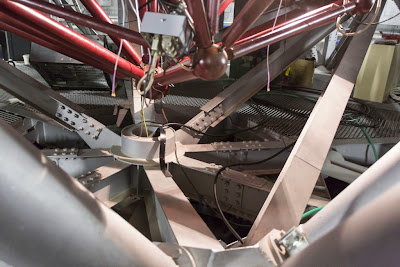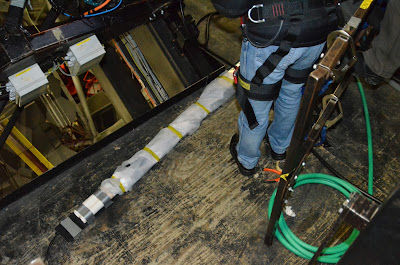The first task for today was to set up a toy "star" to be imaged onto the FIF's acquisition camera. This was done using a blue LED to feed a pinhole & a diffuser placed in front of a microscope objective. The star was defocused to produce a large spot with which the stage positions for the various fibres could be optimised.
So then it was time for Jürgen to start attaching the object & sky fibres to the FIF.
The brass ferrules for the object (left) & sky (right) fibres for the High Stability (HS) mode can be seen just below the CCD chip (near the centre of the photo). This is at the FIF's maximum separation for a mode pair, 29 mm.
Here's the HS pair again, but at the minimum separation of 4 mm.
As above, seen up close...
Installing the fibres was rather a fiddly process, but it's guaranteed to be even fiddlier when doing this up on the tracker!
This shows all the fibres in position, with the FIF jaws at their minimum separation. From top to bottom the four modes are High Stability (HS), High Res (HR), Medium Res (MR) & Low Res (LR).
This is the view from behind.
With the fibres in place, Janus could monitor the counts on the exposure meter to judge how well the spot's aligned to the fibre being tested.
Then he could adjust the FIF stages to determine the best position for
each fibre & save that encoder reading. So now the FIF will offset
reliably to position the object on the required fibre.
With that final task completed, the fibres could be taken out again & bundled up for their scary ride up to the tracker. The fibre ends & the break-out box had to be supported together, but some flexibility would be necessary so a bendy piece of board was used & then the whole lot was wrapped in a thin layer of foam. The fibre ends were also enclosed in plastic tubes for extra protection.
Even IT was willing to get involved in this nerve-wracking process!
One should never look down the barrel...
The team underneath the primary took charge of hauling the precious fibre bundle up through the pintle bearing.
& then carefully feeding it along to the edge of the structure.
Where they could pass the end up to Eben & Johan on the cherry-picker.
Good to see HRS's Papa Bear looking happy at this stage :)
The 50 m long green mamba's now been replaced by a black one...
Apparently this was all pretty amazing to David ;)
This is a great spot to view the primary mirror from.
Having negotiated the loop around the structure node, the aerial guys could proceed up to the tracker.
Safely up on the tracker platform! Whew :)
Now for the real challenge: getting this whole lot through the rho wrap! Not a simple matter since only the sides of the cable wrap can be opened up - the steel ends can't be dismantled so everything has to squeeze through the front & back doors...
All the other cables & pipes had to be man-handled out of the way to make space to push the fibres & box through.
Fortunately the contraption only had to go up through the entrance of the cable wrap & then out the side. Then the cable could be pushed through & looped back down to the exit end of the rho wrap.
Here it could again come in through the side & then exit through the steel frame at the end of the cable wrap.
The delicate bits could then be parked up on the rho stage while the rest of the cable was fed in through the side of the cable wrap. This was a slow process as the plastic slats on the side of the cable wrap had to be removed (before) & replaced (after) pushing the cable into place. We'll finish this up tomorrow...
Thanks to Janus for contributing various cool photos from today's action, & to Jürgen for this one of the Milky Way & Venus taken the other night. Extra neat is the Zodiacal Light visible as a bright wedge extending up from the bottom of the image. This is light scattered off of dust in the plane of our Solar System. It's particularly obvious at the moment as we're about a week past the equinox so the Zodiac is steeply angled with respect to the horizon.
If all goes well, we should complete the installation of the fibres & the FIF tomorrow. So if the weather clears up, we'll go on-sky tomorrow night!




























No comments:
Post a Comment